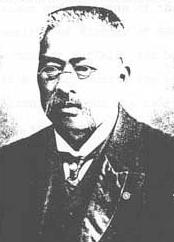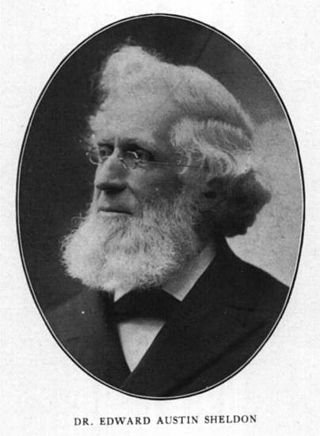Related Research Articles
Progressive education, or educational progressivism, is a pedagogical movement that began in the late 19th century and has persisted in various forms to the present. In Europe, progressive education took the form of the New Education Movement. The term progressive was engaged to distinguish this education from the traditional curricula of the 19th century, which was rooted in classical preparation for the early-industrial university and strongly differentiated by social class. By contrast, progressive education finds its roots in modern, post-industrial experience. Most progressive education programs have these qualities in common:

Educational psychology is the branch of psychology concerned with the scientific study of human learning. The study of learning processes, from both cognitive and behavioral perspectives, allows researchers to understand individual differences in intelligence, cognitive development, affect, motivation, self-regulation, and self-concept, as well as their role in learning. The field of educational psychology relies heavily on quantitative methods, including testing and measurement, to enhance educational activities related to instructional design, classroom management, and assessment, which serve to facilitate learning processes in various educational settings across the lifespan.
A teaching method is a set of principles and methods used by teachers to enable student learning. These strategies are determined partly on subject matter to be taught and partly by the nature of the learner. For a particular teaching method to be appropriate and efficient it has take into account the learner, the nature of the subject matter, and the type of learning it is supposed to bring about.

Student-centered learning, also known as learner-centered education, broadly encompasses methods of teaching that shift the focus of instruction from the teacher to the student. In original usage, student-centered learning aims to develop learner autonomy and independence by putting responsibility for the learning path in the hands of students by imparting to them skills, and the basis on how to learn a specific subject and schemata required to measure up to the specific performance requirement. Student-centered instruction focuses on skills and practices that enable lifelong learning and independent problem-solving. Student-centered learning theory and practice are based on the constructivist learning theory that emphasizes the learner's critical role in constructing meaning from new information and prior experience.

Pedagogy, from Ancient Greek παιδαγωγία (paidagōgía), most commonly understood as the approach to teaching, is the theory and practice of learning, and how this process influences, and is influenced by, the social, political and psychological development of learners. Pedagogy, taken as an academic discipline, is the study of how knowledge and skills are imparted in an educational context, and it considers the interactions that take place during learning. Both the theory and practice of pedagogy vary greatly as they reflect different social, political, and cultural contexts.
A didactic method is a teaching method that follows a consistent scientific approach or educational style to present information to students. The didactic method of instruction is often contrasted with dialectics and the Socratic method; the term can also be used to refer to a specific didactic method, as for instance constructivist didactics.
This is an index of education articles.
This glossary of education-related terms is based on how they commonly are used in Wikipedia articles. This article contains terms starting with G – L. Select a letter from the table of contents to find terms on other articles.

Discovery learning is a technique of inquiry-based learning and is considered a constructivist based approach to education. It is also referred to as problem-based learning, experiential learning and 21st century learning. It is supported by the work of learning theorists and psychologists Jean Piaget, Jerome Bruner, and Seymour Papert.
Traditional education, also known as back-to-basics, conventional education or customary education, refers to long-established customs that society has traditionally used in schools. Some forms of education reform promote the adoption of progressive education practices, and a more holistic approach which focuses on individual students' needs; academics, mental health, and social-emotional learning. In the eyes of reformers, traditional teacher-centered methods focused on rote learning and memorization must be abandoned in favor of student centered and task-based approaches to learning.
Curriculum theory (CT) is an academic discipline devoted to examining and shaping educational curricula. There are many interpretations of CT, being as narrow as the dynamics of the learning process of one child in a classroom to the lifelong learning path an individual takes. CT can be approached from the educational, philosophical, psychological and sociological perspectives. James MacDonald states "one central concern of theorists is identifying the fundamental unit of curriculum with which to build conceptual systems. Whether this be rational decisions, action processes, language patterns, or any other potential unit has not been agreed upon by the theorists." Curriculum theory is fundamentally concerned with values, the historical analysis of curriculum, ways of viewing current educational curriculum and policy decisions, and theorizing about the curricula of the future.

Takamine Hideo was an administrator and educator in Meiji period Japan.
Inquiry-based learning is a form of active learning that starts by posing questions, problems or scenarios. It contrasts with traditional education, which generally relies on the teacher presenting facts and their knowledge about the subject. Inquiry-based learning is often assisted by a facilitator rather than a lecturer. Inquirers will identify and research issues and questions to develop knowledge or solutions. Inquiry-based learning includes problem-based learning, and is generally used in small-scale investigations and projects, as well as research. The inquiry-based instruction is principally very closely related to the development and practice of thinking and problem-solving skills.

Reading is the process of taking in the sense or meaning of letters, symbols, etc., especially by sight or touch.

The Age of Enlightenment dominated advanced thought in Europe from about the 1650s to the 1780s. It developed from a number of sources of “new” ideas, such as challenges to the dogma and authority of the Catholic Church and by increasing interest in the ideas of science, in scientific methods. In philosophy, it called into question traditional ways of thinking. The Enlightenment thinkers wanted the educational system to be modernized and play a more central role in the transmission of those ideas and ideals. The development of educational systems in Europe continued throughout the period of the Enlightenment and into the French Revolution. The improvements in the educational systems produced a larger reading public which resulted in increased demand for printed material from readers across a broader span of social classes with a wider range of interests. After 1800, as the Enlightenment gave way to Romanticism, there was less emphasis on reason and challenge to authority and more support for emerging nationalism and compulsory school attendance.
The Physical Science Study Committee, usually abbreviated as PSSC, was inaugurated at a 1956 conference at MIT to review introductory physics education and to design, implement, and monitor improvements. It produced major new physics textbooks, instructional movies, and classroom laboratory materials, which were used by high schools around the world during the 1960s and 1970s and beyond.
Thomas S. Popkewitz is an professor in the department of curriculum and instruction, University of Wisconsin–Madison School of Education, US. His studies explore historically and contemporary education as practices of making different kinds of people that distribute differences. He has written or edited approximately 40 books and 300 articles in journals and book chapters translated into 17 languages. Recent studies focus on the comparative reason of educational research as cartographies and architectures that produce phantasmagrams of societies, population and differences. The studies entail theoretical, discursive, ethnography, and historical studies that explore school, professional identities, and the relation to conceptions of differences inscribed childhood, learning and cultural differences.

Edward Austin Sheldon was an American educator, and the founding president of State University of New York at Oswego. He also served as superintendent of schools for the cities of Syracuse, New York and Oswego, New York. Sheldon's main achievement was the introduction of the principles and teachings of Johann Heinrich Pestalozzi into American education through the Oswego Movement. His daughter was educator Mary Sheldon Barnes.

Mary Downing Sheldon Barnes was an American educator and historian. Her teaching style and publications were considered ahead of their time. She used a method that encouraged students to develop their own research skills utilizing primary sources and their own problem solving skills. Sheldon was teacher of and major influence on author and socialist Anna Strunsky.
Herbartianism (Her-bart-ti-an-ism) is an educational philosophy, movement, and method loosely based on the educational and pedagogical thought of German educator Johann Friedrich Herbart, and influential on American school pedagogy of the late 19th century as the field worked towards a science of education. Herbart advocated for instruction that introduced new ideas in discrete steps. About a quarter-century after his death, Herbart's ideas were expanded in two German schools of thought that were later embodied in the method used at a practice school in Jena, which attracted educationists from the United States. Herbartianism was later replaced by new pedagogies, such as those of John Dewey.
References
- ↑ Encyclopædia Britannica, http://www.britannica.com/EBchecked/topic/1991686/Oswego-Movement
- ↑ Oswego: Fountainhead of Teacher Education, Dorothy Rogers, Appleton-Century-Crofts, Inc., New York, 1961
- ↑ "Oswego Movement | American educational reform movement".
- ↑ "The enlightenment revolution: A historical study of positive change through science teacher education", Peter Rillero, Journal of Science Teacher Education, Volume 4, Number 2, 37-43, 1993
- ↑ "Oswego Movement | American educational reform movement".